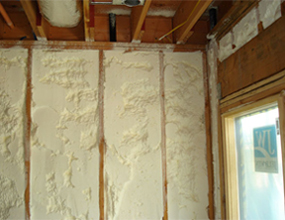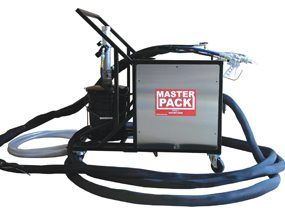Toubleshooting for 2 Component Foam
Troubleshooting Procedures for Touch ‘n Seal Two-Component Disposable Foam Kits 110, 120, 200, 300, 600 & 1000
Refillable Foam Systems: Please review the detailed information on the
refillable systems product page. The below information does not reference the refillable systems. You may also contact our customer service group at
866-799-FOAM.
Checking the Gun for Proper Function
Unequal Chemical Flow from the Tanks
Foam Seems to Rise, Then “Melts”
Inadequate Flow from Both Tanks
Temperature Issues
Foam Cures Soft
Foam Is Very White, Instead of Yellow
Foam Cures with a “Crunchy” Texture
Foam is Very Dark in Color
Only One Chemical is Dispensing
Chemical Clean-Up
Checking the Gun for Proper Function
Good quality foam is dependent upon one-to-one ratio dispensing. The easiest way to determine that you have good ratio is to observe the stream of chemicals coming out of the gun before they pass through the mixing nozzle.
To do this, remove the nozzle from the gun and point the gun into a waste container. Pull the trigger and observe the chemical streams. You should see two chemical streams crossing over each other and flowing at equal velocity.
Know that the "A" component is light brown in color and the "B" component is white (or nearly clear) in color.Ensure you perform proper assembly according to the instructions in your kit.
Unequal Chemical Flow from the Tanks
If you see more "A" chemical flowing than "B" chemical, your foam is probably darker in color and may have a crunchy, glassy surface. First confirm the temperature of the foam, and the ambient temperature. The canisters should be brought to a temperature between 60 & 80ºF, and the ambient temperature should be between 60 and 100ºF. Click here for a chart of temperature ranges.
If the temperature is right for dispensing, then check the "B" component tank. Be sure it is not empty. Be sure the valve is turned all the way on. Shake the tanks vigorously and try again.
If all of these things seem to be right, contact us for further assistance.
If you see more "B" component than "A" component, your foam is probably whiter in color with a spongy surface texture.
First check the temperature. Chemicals that are too warm often result in foam that is rich in "B" component. First confirm the temperature of the foam, and the ambient temperature. The canisters should be brought to a temperature between 60 & 80ºF, and the ambient temperature should be between 60 and 100ºF.
If the temperature seems right, check the "A" component tank. Be sure that it is not empty. Be sure the valve is turned all the way on. Shake the tanks vigorously and try again.
In very extreme cases, you may dispense foam that seems to be rising, then it "melts" or reverts to a liquid after a short period of time. This would indicate that there is no "A" component flow at all.
When was the last time you used the system? We strongly recommend that the gun is dispensed a minimum of once every week, more often in humid climates. Failure to do so will result in a blockage on the "A" component side of the gun.
If there is no chemical flow, the gun/hose assembly will need to be changed.
Inadequate flow from both tanks indicates a general lack of pressure. The only known cause for both tanks to loose pressure is if the kit was used while lying on its side. The chemical tanks are similar to aerosol cans. If you dispense foam while they are on their side, the propellant escapes through the hose and the pressure is lost. There is no remedy for this. You can only prevent this from happening by keeping the systems in their upright position during use.
Back to Top
Temperature Issues
Click here for a chart of temperature ranges
When dispensing polyurethane foam, two temperatures must be considered.
First and most important is the chemical temperature. If the chemical temperature is not right, you will not dispense good quality foam.
Ideal chemical temperature is between 60° F and 80° F.
Good quality foam is light beige in color. It will set up to be tack free in 30 to 45 seconds. After approximately 20 minutes, it will be firm to the touch with a consistent skin.
If the chemicals are too cold, you will likely dispense too much "A" component. This foam will be darker in color and may have a crunchy, glassy surface texture. Warm the tanks, shake them vigorously and check the chemical flow from the face of the gun.
If the chemicals are too warm, you will likely dispense too much "B" component. This foam will be whiter in color and have a spongy surface texture. Cool the tanks, shake them vigorously and check the chemical flow from the face of the gun.
The second temperature consideration is that of the surface temperature. This is important to ensure the optimum yield and in some cases, good adhesion.
Ideal surface temperature is between 60° F and 80° F.
Surfaces that are colder will result in reduced yield. This is caused by the cold surface extracting the heat from the exothermic reaction resulting in a reduced rise, and a reduced yield. If the surface is 40° or colder, the exotherm may also cause condensation, which would be like spraying foam onto a wet surface, and the foam won’t adhere. The only way to determine if this will happen is to do a test patch. If the foam sticks to the cold surface, spray the thinnest layer possible to simply raise the surface temperature to a level that would be closer to ideal temperatures. Allow that layer to cure. Then add the desired thickness to achieve your R-factor.
Surfaces that are too warm may result in the foam curing too fast. This would also result in a reduced yield because the foam would not have enough time to reach the full rise before a tack free state. In addition, extreme cases may result in loss of adhesion because the foam would cure so fast it could not develop a bond to the surface before it hardened.
Back to Top
Foam Cures Very Soft
Foam that dispenses soft is usually also whiter in color.
This is an indication that you dispensed more "B" component than "A" component.
Refer to the section “Checking the Gun for Proper Function” for procedures to confirm and remedy this situation.
Back to Top
Foam is Very White, Instead of Yellow
Foam that is very white in color will also have a soft surface texture. In extreme cases, it may appear to liquefy, or melt shortly after it is dispensed. This is an indication that you have dispensed more "B" chemical than "A" chemical, or in those extreme cases, no "A" chemical at all.
Refer to the section “Checking the Gun for Proper Function” for procedures to confirm and remedy this situation.
Back to Top
Foam Cures with a “Crunchy” Texture
Foam that has a crunchy or friable surface texture will most likely be darker in color that it should be. This is an indication that you are dispensing more "A" chemical than "B" chemical.
Refer to the section “Checking the Gun for Proper Function” for procedures to confirm and remedy this situation.
Back to Top
Foam is Very Dark in Color
Foam that is darker in color usually also has a crunchy or friable surface texture. This is an indication that you are dispensing more "A" component than "B" component
Refer to the section “Checking the Gun for Proper Function”for procedures to confirm and remedy this situation.
Back to Top
Only One Chemical is Dispensing
To assist you in this section, identify the "A" component as being the darker brown liquid and the "B" component as being white or nearly clear in color.
Most often when there is only one chemical coming out of the gun, it will be the "B" component, or whiter chemical. This is usually caused by not using the gun on a regular basis, causing blocking on one side of the gun.
If only "A" component is coming out something has occurred to freeze up the "B" component side of the gun. Most likely, the gun and hose assembly had been sitting much too long between applications.
The "A" component is very sensitive to humidity. When exposed (and it can be exposed through the hoses), it forms small dark crystal that form on the inner side of the hoses or in the small spaces between the inner workings of the dispensing gun.
If you use the gun a MINIMUM of once per week (even more often in humid climates), the constant flow of chemical will eliminate these crystals from forming. If the gun and hose assembly sits for too long, these crystals form, and when you pull the trigger the next time, they either create a blockage or completely freeze up the inner works.
To prevent this from happening, USE THE GUN AT LEAST ONCE PER WEEK (more often in humid climates).
To fix the problem, you will need to purchase a new gun and hose assembly.
To be sure that both chemicals are dispensing from the gun PRIOR to your application, always do a test shot into a waste container prior to actually dispensing the foam. If the resulting shot looks suspicious, follow the procedure in the section “Checking the Gun for Proper Function” for procedures to confirm and remedy this situation.
Back to Top
Chemical Clean-Up
Evacuate and ventilate spill area, dike spill to prevent entry into water system, wear full protective equipment including respiratory equipment during clean up.
Contain spill and collect using suitable absorbent material, such as sawdust, vermiculite, or other absorbent. Shovel into open containers and dispose as ordinary industrial waste in compliance with local regulations.
Cleanup of "B" component can be accomplished using soap and water, however, get it while it is still in the liquid state.
Cleanup of "A" component is very tricky. Absorb the isocyanate with suitable absorbent material, such as sawdust, vermiculite, or other absorbent. Treat with neutralizing solution consisting of 90% water, 7% ammonia and 3% detergent. Add about 10 parts of neutralizer per part of isocyanate with mixing. Allow standing for 48 hours letting evolved carbon dioxide escape. Decontaminate spill area using neutralizing solution and letting stand over affected areas for at least 10 minutes.
For a small amount of chemical, saturate a rag with dish soap and wipe it up. Be sure to do this while the chemical is still liquid. And be aware that there will most likely be a stain.
If a transportation spill involved, immediately call CHEMTREC at 1-800-424-9300
Back to Top



